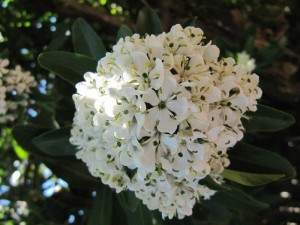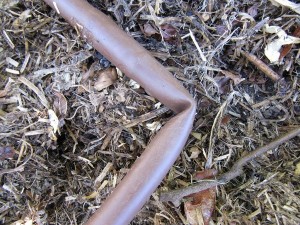THE Escallonia bifida is an extremely hardy evergreen shrub flowering in summer/early autumn.

Close-up of Escallonia bifida.
As an example of its hardiness, the specimen pictured in our garden was about 4.5m tall until we did an extension. Then it had to be severely pruned back to 2m tall, ending up with no leaves, just bare branches.
Within six months it was in full leaf and flower, as seen here.
There are more than 50 varieties of Escallonia grown, although some are harder to find than others. Most gardeners are familiar with Escallonia.
“Hedge with an Edge”, a low-growing, pink-flowered shrub, ideal for bordering paths. This is also sold under E. “Pink Pixie”.

Six months’ new growth on Escallonia bifida.
Being from South America, dry weather does not worry them.
YEARS ago I recommended pine needles as mulch. It is particularly beneficial when the loose needles on top are scraped back to use the composting needles underneath.
Then the 2003 fires came and most of the pine forests went. However, there are still pockets of pine trees in the suburbs and this mulch is free. It can be used as is or shredded, say with the mower, for a finer mulch, ie on the tops of pots. Pine needles are perfect for acid-loving plants such as daphne, rhododendron, azaleas and all Aussie plants.
THE long-held idea of not planting roses where they have been planted previously has now been turned on its head in the UK’s Royal Horticultural Society’s latest edition of “The Garden”. Colin Crosbie, curator of the RHS Garden at Wisley, reports that “this is no longer held as a universal truth, but what has endured as the most important factor is good soil. Improving it with the addition of well-rotted farmyard manure or garden compost is the start.”
Crosbie goes on to say that thoughts on planting depths have also changed. Most of us were taught to plant roses with the bud graft union at level with, or slightly above, the surrounding soil level.
Nowadays, best practice is to plant with the graft union buried a few centimetres below the surrounding soil level, as this will reduce “wind rock”, particularly in windy areas as is the case in Canberra and especially in new, exposed areas.
This news may help influence new plantings or replacing roses when the new stock arrives in winter.
Watch out for kinks

A kink in an irrigation drip line could cost you plants!
This photo clearly illustrates what can happen, in this case in our garden, where a kink in the line meant no water was getting to the plants. It is essential to ensure drip lines are on top of the soil and under the mulch. This may mean lifting drip lines if buried in soil and at the same time checking there are no kinks or breaks in the line. I suggest this as a matter of urgency as this month is predicted to be just as hot as January.
Jottings…
- Do not let container-grown camellias dry out as they are now forming buds for next year.
- Stop tomatoes after four fruit trusses have set; more will possibly not ripen in time.
- Keep feeding container plants with high potassium, such as tomato food, for continuous flowering.
- Trim lavender to remove old flower spikes just into the old wood.
The post Hardy evergreen that loves hot weather appeared first on Canberra CityNews.



















